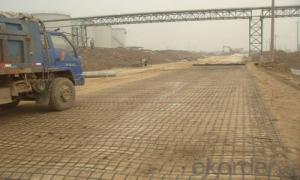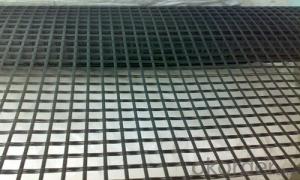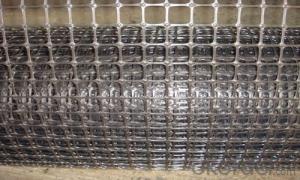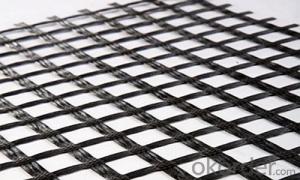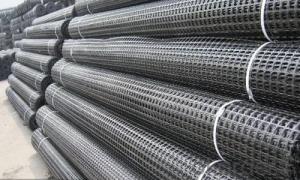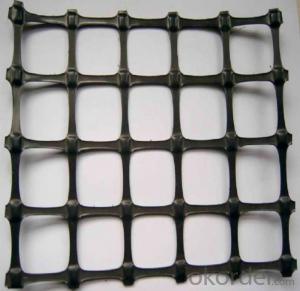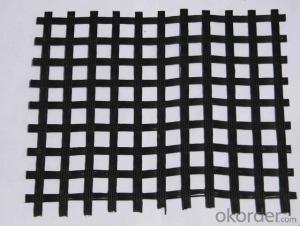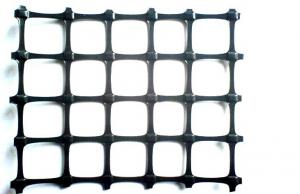Reinforcement and Separation Fiberglass Geogrid with Good Quality in Civil Engineering Construction
- Loading Port:
- China main port
- Payment Terms:
- TT OR LC
- Min Order Qty:
- 1000 m²
- Supply Capability:
- 1000000 m²/month
OKorder Service Pledge
OKorder Financial Service
You Might Also Like
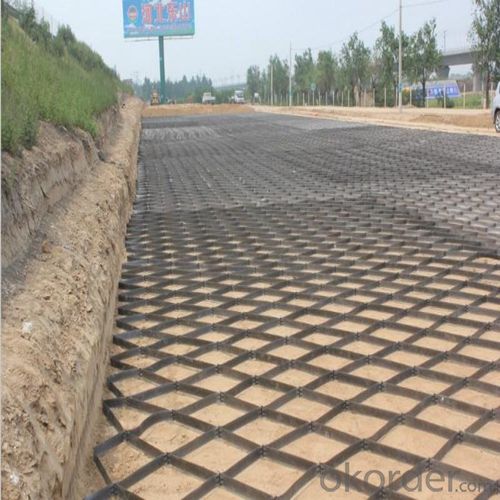
Porducts Description
Classify Fiberglass Geogrid Classify Polyester Geogrid
Material Fiberglass Material Polyester
Tensile Strength: 25-25KN; 30-30KN; 50-50KN; 80-80KN; 100-100KN; 120-120KN;
Road Size: 3.95x100m; as customer required;
A geogrid is geosynthetic material used to reinforce soils and similar materials. Geogrids are commonly used to reinforce retaining walls, as well as subbases or subsoils below roads or structures. Soils pull apart under tension. Compared to soil, geogrids are strong in tension. This fact allows them to transfer forces to a larger area of soil than would otherwise be the case.
Our Service
Quality assurance
1.On a regular basis or as per your request,we entrust national testing agencies to conduct quality inspections
2. Strictly in accordance with the ISO9001-2008 international quality system standard,we monitor and manage the whole process throughout production,quality testing,and measurement to ensure product quality
3. For quality-related construction delay or substandard construction(except for damage or losses due to customer’s responsibility or irresistible natural disasters),we have refunding,replacement,and repair services.We will respond to customers’ feedbacks on quality issues within 24 hours.
Packaging & Shipping
Packing: PLASTIC FILM INSIDE, AND WOVEN BAG OUTSIDE
Shipping: About 15 days after receipt the deposit
FAQ:
Q: What kind of payments does jenor support?
A: T/T, L/C, Cash are accepted.
Q: Do you charge for the samples?
A: Accordeing to our company policy, the samples are free, we only charge the freight fee. And we will return the freight fee during the next order.
Q: Can you produce according to customers' design?
A: Sure, we are professional manufacturer, OEM and ODM are both welcome.
Q: Do you have other products?
A: Yes, please check the pictures:
- Q:What is the recommended spacing between geogrid layers?
- The recommended spacing between geogrid layers can vary depending on the specific project and soil conditions. However, in general, a spacing of about 2 to 3 feet (0.6 to 0.9 meters) is often recommended to achieve optimal reinforcement and stability.
- Q:Are geogrids effective in reducing soil erosion?
- Yes, geogrids are effective in reducing soil erosion. Geogrids are engineered materials that can be placed in soil to stabilize it and prevent erosion. They provide reinforcement to the soil, increasing its strength and resistance to erosion caused by wind, water, or other factors. By reducing soil erosion, geogrids help to maintain the integrity of slopes, embankments, and other structures, ultimately protecting the environment and promoting sustainable land use.
- Q:Are geogrids suitable for use in high-temperature environments?
- Yes, geogrids are suitable for use in high-temperature environments. Geogrids are constructed using materials that have high resistance to temperature, ensuring their durability and effectiveness even in extreme heat conditions. They can withstand elevated temperatures without losing their structural integrity, making them a reliable choice for various applications in high-temperature environments.
- Q:What are the factors that influence the design and selection of geogrids for reinforcement?
- The factors that influence the design and selection of geogrids for reinforcement include the type and properties of the soil, the load and traffic conditions, the desired level of reinforcement, the project lifespan, the installation and construction method, and the environmental conditions.
- Q:What are the differences between geogrids and geocomposites?
- Geogrids and geocomposites are both used in soil stabilization and reinforcement applications, but they have some key differences. Geogrids are typically made from high-strength polymers or fiberglass, and they have a grid-like structure with open spaces. They are designed to provide tensile strength and distribute loads across a wider area. Geogrids are mainly used for reinforcing soils, retaining walls, and roadways. On the other hand, geocomposites are multi-layered materials that combine different geosynthetic components. They usually consist of a geotextile fabric or membrane bonded to a geogrid or geonet layer. Geocomposites offer a combination of functions such as filtration, drainage, separation, and reinforcement. They are commonly used in applications like erosion control, landfill engineering, and drainage systems. In summary, while geogrids focus on reinforcement and load distribution, geocomposites offer a more versatile solution by combining multiple functions in a single product.
- Q:Can geogrids be used in landfill applications?
- Yes, geogrids can be used in landfill applications. They are commonly used to reinforce and stabilize the soil in landfills, preventing erosion and providing structural support. Geogrids can help improve the overall performance and lifespan of the landfill by enhancing stability and reducing settlement.
- Q:How to choose 15kn bidirectional geogrid geogrid
- First of all, in the choice of geogrid types, according to the construction project categories selected, according to the environmental impact of the project in which the same project many times in different environments with different types of grid.
- Q:Can geogrids be used in mining haul roads?
- Yes, geogrids can be used in mining haul roads. Geogrids are commonly used in construction and infrastructure projects to improve the stability and load-bearing capacity of roads. In mining operations, haul roads are subjected to heavy loads from trucks and equipment. By incorporating geogrids into the road design, they can provide reinforcement and prevent soil or aggregate movement, ultimately increasing the lifespan and durability of the haul roads in mining environments.
- Q:Are geogrids suitable for use in steep slopes?
- Yes, geogrids are suitable for use in steep slopes. They provide reinforcement and stability to the soil, reducing the risk of erosion and landslides. Geogrids are designed to distribute loads and improve the overall strength of the slope, making them an effective solution for steep terrain.
- Q:What are the long-term performance characteristics of geogrids?
- The long-term performance characteristics of geogrids include high tensile strength, durability, and resistance to creep or deformation over time. Geogrids also exhibit excellent resistance to chemical and biological degradation, making them suitable for long-term applications in various civil engineering and construction projects. Additionally, geogrids provide long-lasting reinforcement and stabilization to soils, helping to maintain their structural integrity and prevent soil erosion.
1. Manufacturer Overview |
|
|---|---|
| Location | |
| Year Established | |
| Annual Output Value | |
| Main Markets | |
| Company Certifications | |
2. Manufacturer Certificates |
|
|---|---|
| a) Certification Name | |
| Range | |
| Reference | |
| Validity Period | |
3. Manufacturer Capability |
|
|---|---|
| a)Trade Capacity | |
| Nearest Port | |
| Export Percentage | |
| No.of Employees in Trade Department | |
| Language Spoken: | |
| b)Factory Information | |
| Factory Size: | |
| No. of Production Lines | |
| Contract Manufacturing | |
| Product Price Range | |
Send your message to us
Reinforcement and Separation Fiberglass Geogrid with Good Quality in Civil Engineering Construction
- Loading Port:
- China main port
- Payment Terms:
- TT OR LC
- Min Order Qty:
- 1000 m²
- Supply Capability:
- 1000000 m²/month
OKorder Service Pledge
OKorder Financial Service
Similar products
New products
Hot products
Related keywords
